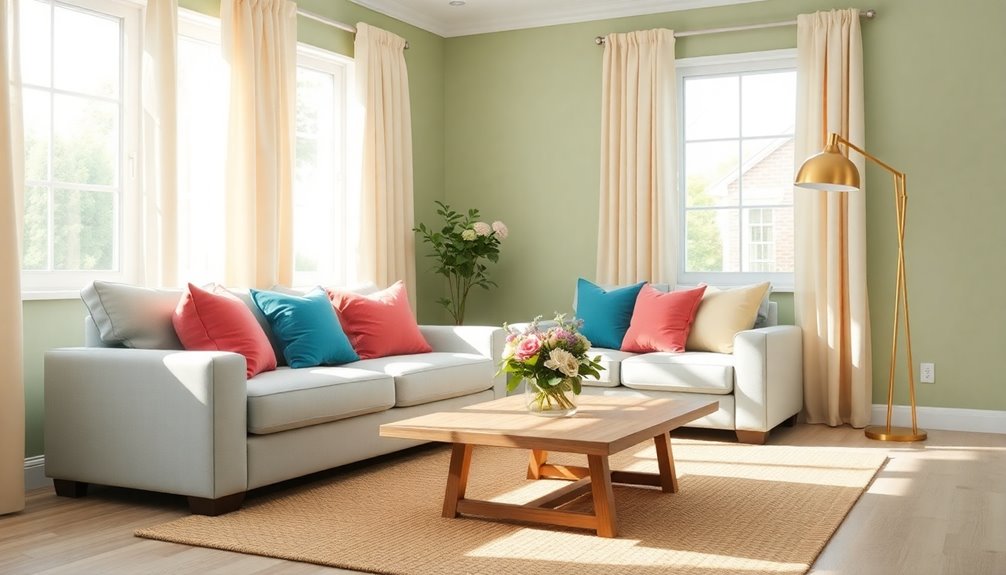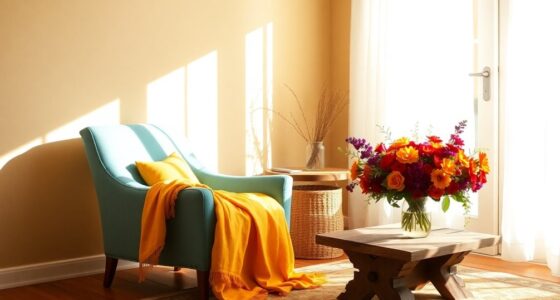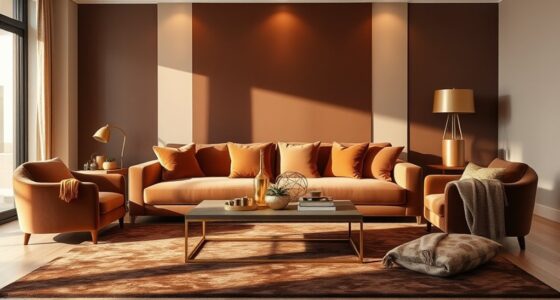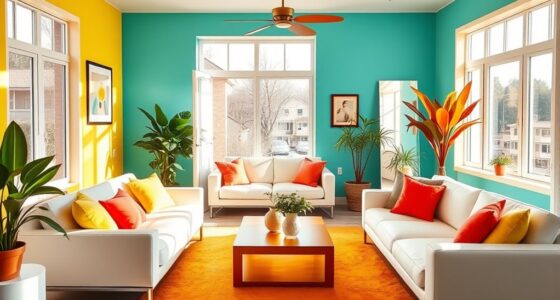To create a safe and chic elderly home, you'll want to contemplate colors that foster comfort and well-being. Use warm yellow for a cheerful atmosphere and calming blue for relaxation. Soft pink offers a gentle touch, while revitalizing green connects to nature. Energetic orange boosts liveliness, invigorating red stimulates appetite, and soothing lavender reduces anxiety. Crisp white enhances brightness, and deep purple inspires creativity. Each choice makes a difference in the space. Stick around to discover even more insights!
Key Takeaways
- Warm yellow creates a cheerful atmosphere, enhancing mood and encouraging social interactions among seniors in their homes.
- Soft pink adds a gentle touch, providing emotional comfort and reducing anxiety, especially beneficial for memory-related issues.
- Calming blue promotes serenity and relaxation, making spaces feel tranquil and suitable for areas like bedrooms and bathrooms.
- Crisp white enhances natural light flow, reduces visual clutter, and creates an illusion of spaciousness, aiding mobility for seniors.
- Refreshing green connects residents to nature, promoting well-being and encouraging social interaction in communal areas.
Warm Yellow for Comfort and Cheer
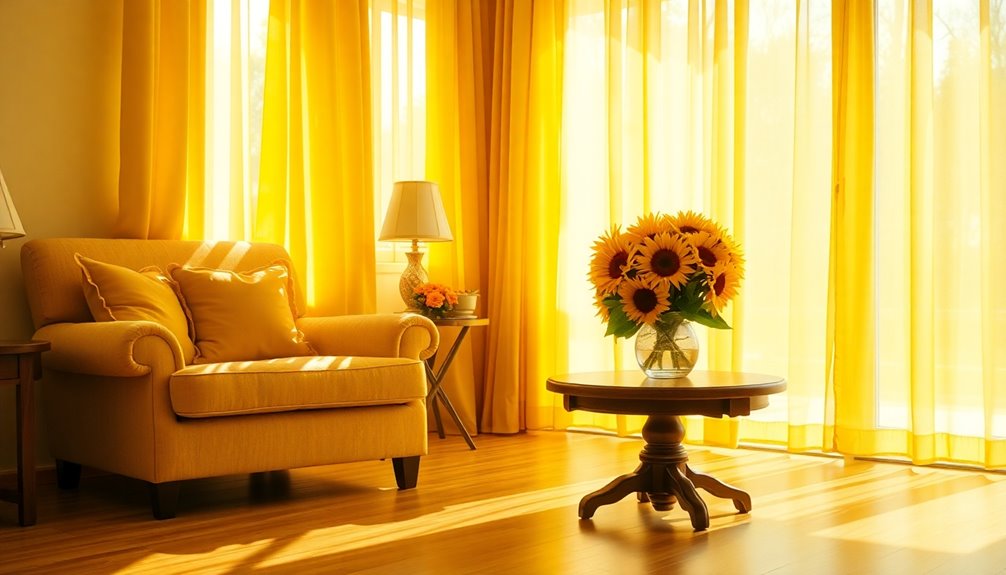
When you choose warm yellow for an elderly home, you create a space that feels both inviting and cheerful. This color scheme evokes feelings of sunshine, ideal for living and dining areas where seniors gather.
Softer shades of yellow prevent overwhelming brightness, ensuring comfort in these environments. By incorporating warm yellow tones, you can enhance the mood and overall well-being of residents, particularly those grappling with isolation or depression.
Yellow's association with energy and optimism makes it a strategic choice for communal spaces, encouraging social interaction among residents. Additionally, incorporating social interaction can foster a sense of community and belonging among seniors.
Professional caregivers can use warm yellow accents in decor to create uplifting spaces, fostering emotional comfort and happiness for seniors. It's a simple yet effective way to brighten their daily lives.
Calming Blue for Serenity and Relaxation
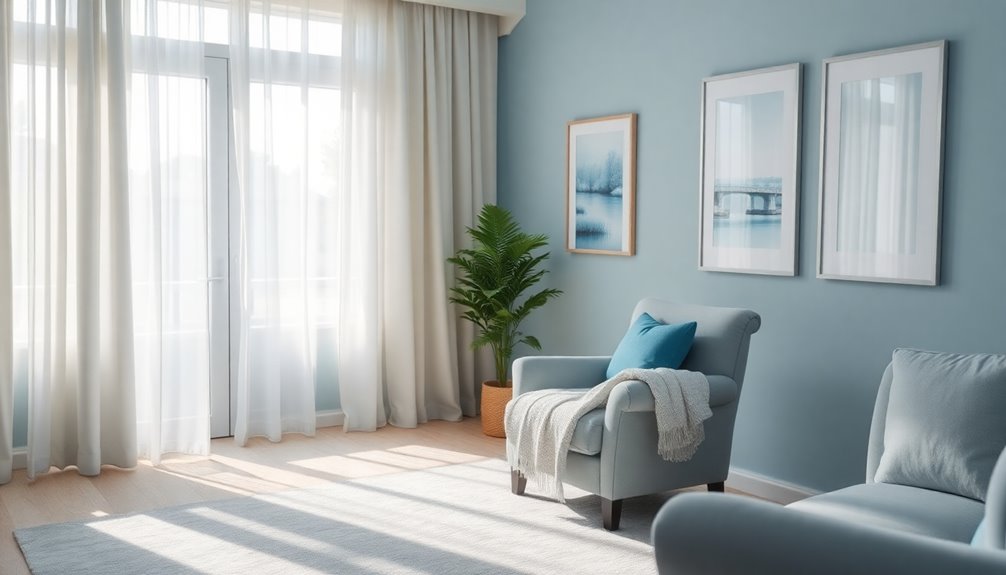
Calming blue hues create an inviting atmosphere that promotes serenity and relaxation, making them perfect for spaces where seniors spend their time, like living rooms and bedrooms.
This color, reminiscent of the ocean and sky, evokes tranquility, helping to reduce anxiety levels. You can enhance the serene vibe by incorporating soft blue throw blankets or cushions, especially during warmer months, encouraging leisurely, comforting moments.
Its frequent use in spa and bathroom designs highlights its restorative qualities, fostering mental well-being. Additionally, using air purifiers can improve indoor air quality, further enhancing the calming environment for seniors.
However, be mindful to avoid soft blue in winter months, as it can create a colder atmosphere that might affect comfort levels.
Choose calming blue for a peaceful and inviting home environment for your loved ones.
Soft Pink for a Gentle Touch
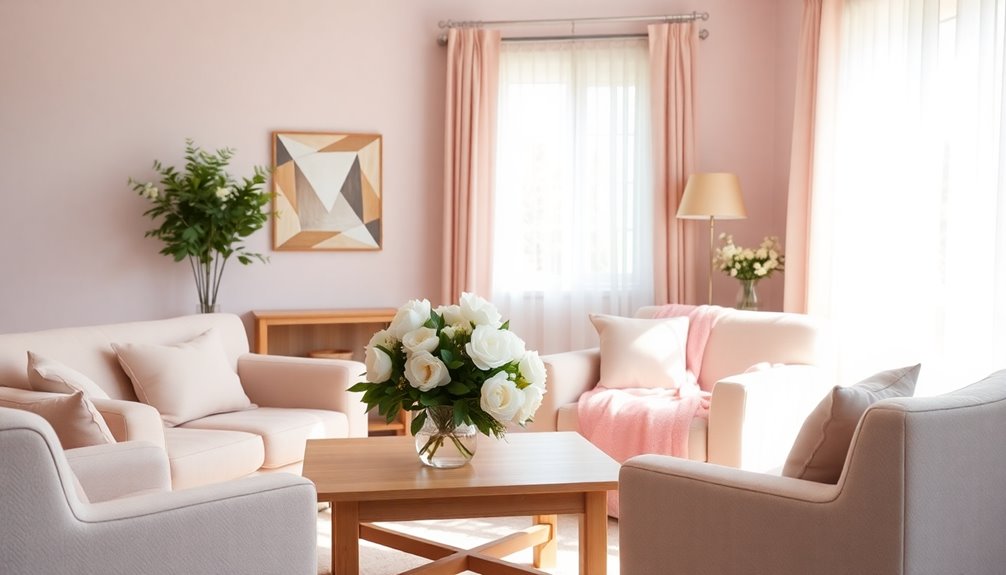
Soft pink walls can transform a space into a warm and inviting haven, perfect for promoting relaxation and enhancing mood in senior living areas. This gentle hue evokes feelings of comfort and safety, making it ideal for bedrooms and common areas.
The calming effect of soft pink may help reduce anxiety, especially for seniors with memory issues, fostering tranquility and improving their quality of life. Incorporating elements that stimulate emotional intelligence can further enhance the overall atmosphere, creating a nurturing environment.
You can also use soft pink as an accent color, adding stylish touches without overwhelming the senses. Incorporating soft pink elements like throw pillows or decorative accessories personalizes the space while maintaining a chic aesthetic.
Ultimately, soft pink creates a soothing environment that encourages well-being and comfort for seniors.
Refreshing Green for Connection to Nature
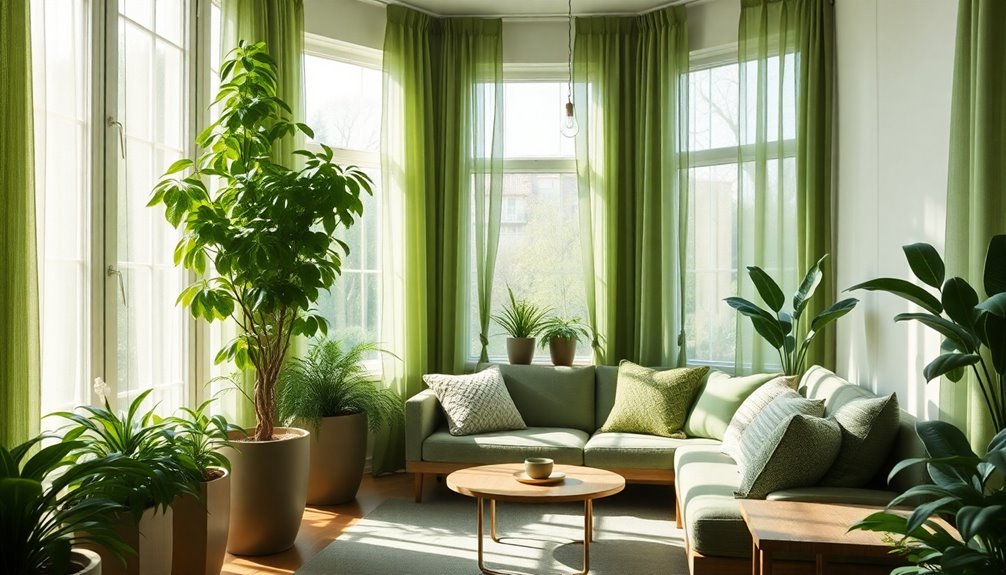
Revitalizing green can instantly bring a sense of tranquility and connection to nature into your home, making it an excellent choice for spaces designed for seniors. This calming color promotes well-being and evokes feelings of comfort and relaxation. With various shades of green available, you can create a visually engaging environment that enhances social interaction in entertainment areas. Incorporating green can also be seen as a reflection of positive thinking, which is linked to improved mental well-being.
| Shade of Green | Effect on Well-being |
|---|---|
| Light Green | Invokes freshness and energy |
| Olive Green | Creates warmth and comfort |
| Emerald Green | Evokes relaxation and security |
| Mint Green | Enhances creativity and calm |
| Forest Green | Promotes a strong connection to nature |
Incorporating green accents can truly transform your space!
Energetic Orange for Vitality and Engagement
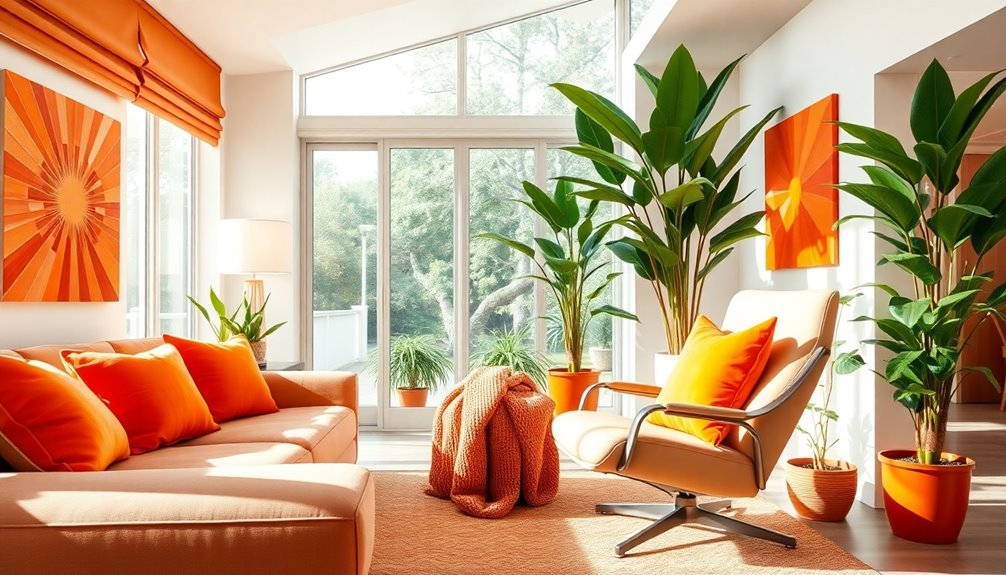
Colors like rejuvenating green create a serene atmosphere, but adding energetic orange can elevate that environment with energy and engagement. This vibrant hue evokes warmth and enthusiasm, perfect for spaces where social interaction thrives.
Consider these benefits of incorporating energetic orange:
- Stimulates mental activity and boosts energy levels
- Brightens small spaces, creating an inviting atmosphere
- Enhances positivity and uplifts mood among residents
- Supports emotional well-being, combating feelings of lethargy
Utilizing lighter shades can brighten a room without overwhelming it, while deeper tones offer a calming effect. Additionally, incorporating lighting design can further enhance the overall ambiance and effectiveness of color choices in the space.
Warm Brown for Safety and Security
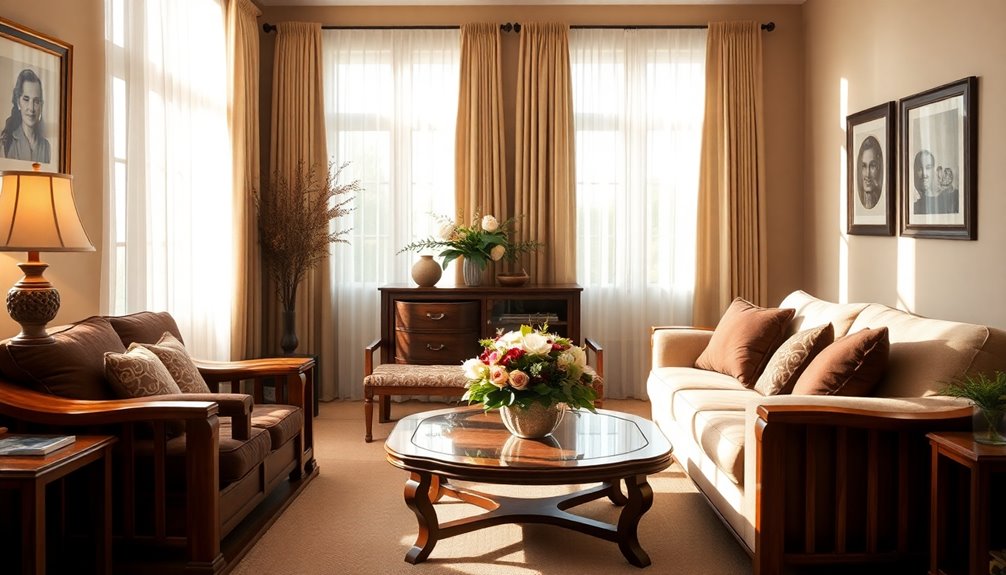
Warm brown tones, particularly rich cocoa shades, create a cozy atmosphere that makes seniors feel safe and secure in their homes.
In senior living environments, these warm brown hues foster a cocoon-like feeling, promoting comfort and relaxation. Incorporating brown accents, like pillows and rugs, enhances the inviting nature of gathering spaces, making them perfect for socializing or unwinding.
The grounding effect of brown helps alleviate anxiety, promoting stability for elderly residents. Additionally, natural wood elements in brown tones evoke a connection to nature, further enhancing emotional well-being. Color therapy suggests that these comforting shades can create indulgent, protective spaces, essential for your mental health as you age gracefully in your home.
Research shows that secure attachment bonds can significantly contribute to emotional stability, making warm brown a nurturing color choice for a safe environment.
Choose warm brown for a nurturing environment.
Invigorating Red for Appetite Stimulation
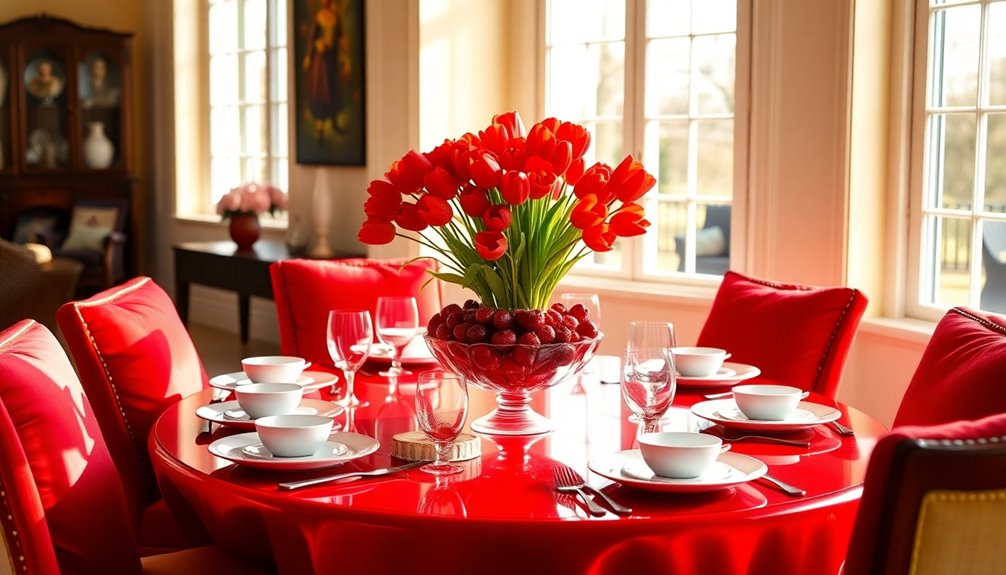
When you want to create an inviting dining space for seniors, invigorating red can be a powerful choice. This vibrant color isn't just eye-catching; it's known to stimulate appetite and increase excitement during meals.
Here are a few ways to incorporate red effectively:
- Use bright red tablecloths to create a lively atmosphere.
- Add red window accents for a pop of color and energy.
- Consider full red walls if it fits your design scheme.
- Incorporate red accents in winter breakfast nooks to combat sluggishness.
Soothing Lavender for Reduced Anxiety
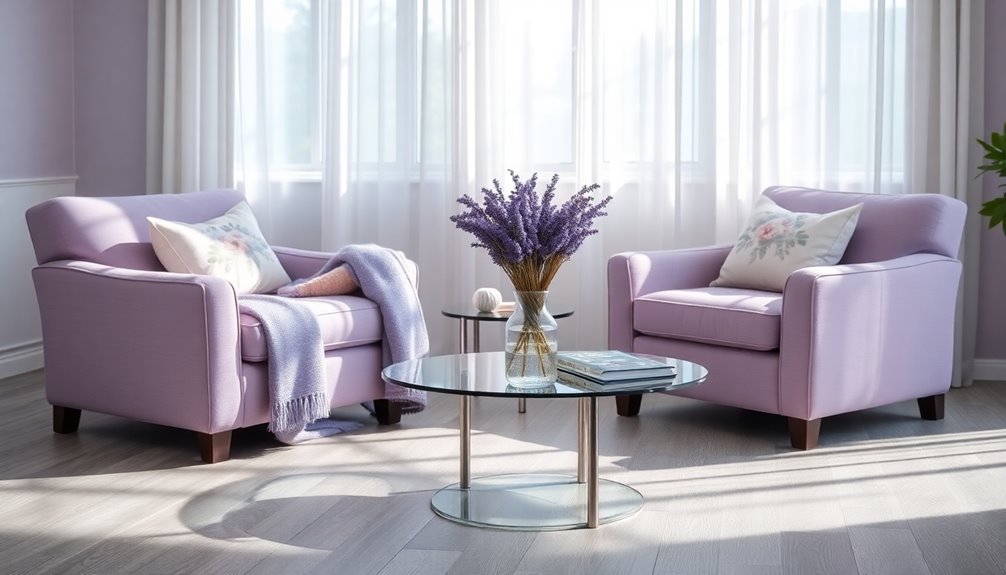
Soothing lavender can transform your space into a calming haven, perfect for reducing anxiety and promoting relaxation.
It works wonders in bedrooms and relaxation areas, enhancing mood stability for seniors.
Calming Color Effects
Color choices can greatly impact your emotional well-being, especially in environments designed for seniors. Soothing lavender stands out for its calming color effects, helping to reduce anxiety and promote relaxation.
Here are some reasons to contemplate this gentle hue:
- Reduces stress levels, fostering peace.
- Enhances cognitive function and emotional well-being.
- Provides a sense of comfort and familiarity.
- Ideal for bedrooms or living areas where seniors spend time.
Incorporating soothing lavender into your space can create a tranquil atmosphere, particularly beneficial for seniors facing memory issues or anxiety.
Whether through wall paint or accents like throw pillows, lavender offers a serene aesthetic that nurtures both safety and serenity in elderly living spaces.
Ideal Room Applications
Incorporating soothing lavender into your elderly home can transform various spaces into calming retreats that promote relaxation and reduce anxiety.
Use lavender in bedrooms to create an oasis for restorative sleep and mental tranquility. You'll find that its soft hue fosters a peaceful atmosphere, essential for winding down at the end of the day.
In communal areas, consider adding lavender accents like throw pillows or curtains, which enhance your color palette while maintaining a sense of home. This versatile color pairs beautifully with neutral tones, ensuring a serene environment without overwhelming the senses.
Research shows that such gentle colors positively influence mood, particularly benefiting seniors with dementia, making lavender an ideal choice for your elderly home. Additionally, the emotional distress linked to parental infidelity can be mitigated by creating a soothing environment that promotes stability and comfort.
Enhancing Mood Stability
Creating a calming environment in your elderly home can greatly enhance mood stability. Soothing lavender is an excellent color choice, known for reducing anxiety and promoting relaxation. By incorporating this gentle hue, you create a serene ambiance that fosters comfort and tranquility.
Consider these benefits of using lavender:
- Lowers stress levels
- Promotes relaxation
- Enhances overall well-being
- Contributes to a sense of safety
Using lavender tones in decor and furnishings not only elevates the aesthetic but also positively influences emotional states, especially for seniors dealing with anxiety or dementia.
Pair lavender with natural light to further enhance mood stability and cognitive function, making your space a supportive haven for emotional health.
Crisp White for Brightness and Clarity
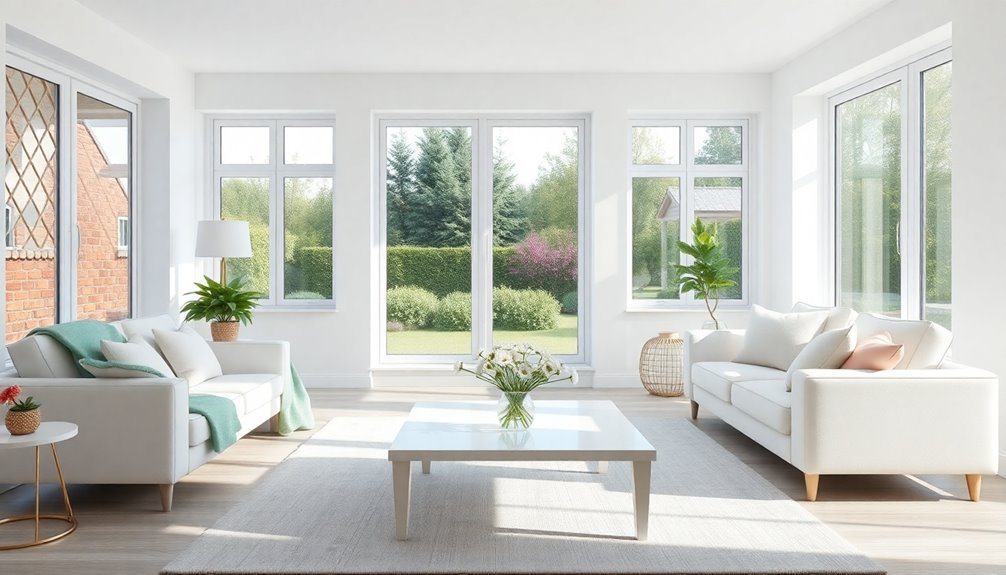
Crisp white can transform your living space by enhancing natural light flow and promoting a sense of openness.
This clean aesthetic not only makes rooms feel larger but also reflects a fresh and inviting atmosphere.
Enhances Natural Light Flow
When you choose crisp white walls for your home, you instantly enhance the flow of natural light. This is especially beneficial in living areas with large windows, where sunlight can reflect off the white surfaces, brightening the space.
Here are some key benefits of using white in your decor:
- Reflects natural light for a brighter atmosphere
- Creates a strong contrast against furnishings, aiding visibility
- Reduces visual clutter for a calming effect
- Promotes an open, airy feel that enhances well-being. Additionally, a clean environment can reduce allergens and pollutants, contributing to improved indoor air quality.
Promotes Space Perception
White walls don't just enhance natural light; they also greatly impact how we perceive space. By choosing crisp white as your primary color, you create an illusion of a larger, more open area, which is especially important for seniors facing mobility challenges.
The reflective quality of white surfaces boosts natural light, fostering an uplifting environment essential for emotional well-being. This neutral backdrop helps create contrast with furnishings, making it easier for seniors with vision impairments to navigate their homes.
Strategically using white can define different areas within open floor plans, enhancing spatial awareness and minimizing confusion. Incorporating white elements, like furniture or accents, promotes a clean, organized look that instills a sense of calm and safety for elderly residents. Additionally, creating a serene environment can be complemented by using essential oils for calming effects, which may further enhance the overall atmosphere of the home.
Reflects Clean Aesthetic
A bright, airy atmosphere can considerably enhance the living experience for seniors, and incorporating crisp white into your home is a simple yet effective way to achieve this.
The right color can transform senior living spaces by:
- Reflecting natural light, making rooms feel larger
- Promoting a sense of cleanliness and calmness
- Aiding navigation with contrast against darker furniture
- Ensuring easy maintenance and quick identification of spills
Crisp white walls and furnishings create clarity, which is especially beneficial for residents with mobility challenges or vision impairments.
This color choice not only evokes feelings of tranquility but also contributes to a safe environment, making it easier for seniors to relax and feel at home.
Deep Purple for Creativity and Inspiration
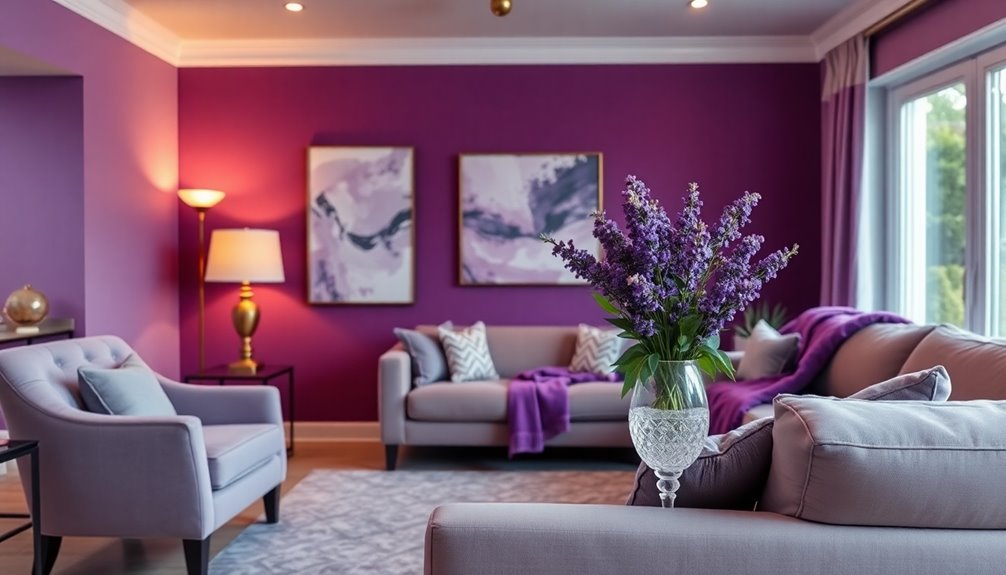
Deep purple can be a powerful ally in fostering creativity and inspiration within your home. This rich hue stimulates the creative part of the brain, making it perfect for offices or craft rooms. By incorporating deep purple, you can inspire seniors to engage in hobbies that promote mental well-being while aging in place. To maintain a cozy atmosphere, balance deep purple with warmer tones. Avoid using it in bedrooms as it may disrupt restful sleep. Additionally, engaging in creative activities can enhance emotional regulation, contributing to overall mental health and well-being in seniors.
| Color Use | Benefits | Tips |
|---|---|---|
| Craft Rooms | Enhances creativity | Combine with warm tones |
| Living Spaces | Sparks innovation | Use as accent colors |
| Seasonal Decor | Invites coziness | Pair with light purples |
| Art Nooks | Encourages artistic flow | Keep it inviting |
| Study Areas | Boosts focus | Balance with neutrals |
Frequently Asked Questions
What Are the Elderly Friendly Colors?
When choosing elderly-friendly colors, think about shades that evoke comfort and calm.
Warm yellows can brighten spaces without overwhelming, while soft blues promote relaxation.
Deep greens connect you to nature, enhancing a soothing environment.
Cozy browns create a secure atmosphere, perfect for gathering areas.
Light purples can inspire creativity in craft spaces, but you might want to avoid them in bedrooms to maintain a peaceful ambiance.
These colors can truly elevate your surroundings!
What Color Is Calming for the Elderly?
Choosing a calming color for the elderly is like wrapping them in a soft, warm blanket.
Soft blues can wash over a space, promoting relaxation and tranquility, similar to a gentle ocean breeze.
Gentle greens, particularly bluish tones, evoke nature's peace, while warm yellows or peaches can stir comfort and joy.
Lavender's soothing hues help reduce anxiety, making it perfect for bedrooms.
Avoid bright, contrasting colors, as they may disorient and disturb emotional well-being.
What Colors Do Elderly See Best?
When considering what colors elderly people see best, you should focus on shades of green. Their eyes can differentiate more shades of green, making it easier for them to perceive.
Additionally, warm tones like soft yellows and peaches are comforting and promote a sense of well-being. High-contrast color schemes also help with spatial awareness, reducing the risk of falls.
Using these color choices can enhance visibility and comfort for seniors in any environment.
What Colors Are Most Desirable in the Décor of a Nursing Home or Senior Living Setting?
In a nursing home or senior living setting, you'll want to choose colors that create a welcoming atmosphere.
Warm yellows can brighten up communal areas, promoting happiness. For bedrooms, soft blues help foster calmness and reduce anxiety.
Deep greens connect residents to nature and offer comfort.
Don't forget safe contrasting colors for furnishings and flooring to aid mobility, while neutral backdrops allow vibrant accents to enhance the overall aesthetic.
Conclusion
By thoughtfully choosing these ten colors, you can transform an elderly home into a vibrant haven that nurtures both comfort and safety. Each hue, like a warm embrace, invites peace or energizes the spirit, creating spaces where your loved ones can thrive. Remember, it’s not just about aesthetics; it’s about crafting an environment that fosters well-being and joy. With the right palette, you’ll paint a canvas of happiness that truly feels like home. Incorporating soothing color palettes for elderly homes can significantly enhance the emotional landscape of the space. Soft blues and gentle greens can evoke a sense of tranquility, while warm yellows and muted oranges can inspire warmth and positivity. These color choices not only elevate the visual appeal but also promote relaxation, encouraging your loved ones to enjoy their surroundings to the fullest.
